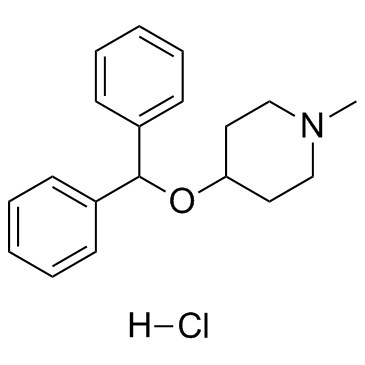Diphenylpyraline (hydrochloride)

Diphenylpyraline (hydrochloride) structure
|
Common Name | Diphenylpyraline (hydrochloride) | ||
|---|---|---|---|---|
| CAS Number | 132-18-3 | Molecular Weight | 317.85300 | |
| Density | N/A | Boiling Point | 378.7ºC at 760mmHg | |
| Molecular Formula | C19H24ClNO | Melting Point | 203-205ºC(lit.) | |
| MSDS | Chinese USA | Flash Point | 111.6ºC | |
| Symbol |

GHS07 |
Signal Word | Warning | |
Use of Diphenylpyraline (hydrochloride)Diphenylpyraline Hcl is a first-generation antihistamine with anticholinergic effects, acts as a dopamine reuptake inhibitor, shows to be useful in the treatment of Parkinsonism. |
| Name | 4-benzhydryloxy-1-methylpiperidine,hydrochloride |
|---|---|
| Synonym | More Synonyms |
| Description | Diphenylpyraline Hcl is a first-generation antihistamine with anticholinergic effects, acts as a dopamine reuptake inhibitor, shows to be useful in the treatment of Parkinsonism. |
|---|---|
| Related Catalog |
| Boiling Point | 378.7ºC at 760mmHg |
|---|---|
| Melting Point | 203-205ºC(lit.) |
| Molecular Formula | C19H24ClNO |
| Molecular Weight | 317.85300 |
| Flash Point | 111.6ºC |
| Exact Mass | 317.15500 |
| PSA | 12.47000 |
| LogP | 4.62670 |
| Vapour Pressure | 6.18E-06mmHg at 25°C |
| InChIKey | LPRLDRXGWKXRMQ-UHFFFAOYSA-N |
| SMILES | CN1CCC(OC(c2ccccc2)c2ccccc2)CC1.Cl |
| Storage condition | -20℃ |
CHEMICAL IDENTIFICATION
HEALTH HAZARD DATAACUTE TOXICITY DATA
|
| Symbol |

GHS07 |
|---|---|
| Signal Word | Warning |
| Hazard Statements | H302 |
| Personal Protective Equipment | dust mask type N95 (US);Eyeshields;Gloves |
| Hazard Codes | Xn: Harmful; |
| Risk Phrases | R20/21/22;R36/37/38 |
| RIDADR | UN 3249 |
| RTECS | TM7823600 |
| Packaging Group | III |
| Hazard Class | 6.1(b) |
| HS Code | 2933399090 |
| HS Code | 2933399090 |
|---|---|
| Summary | 2933399090. other compounds containing an unfused pyridine ring (whether or not hydrogenated) in the structure. VAT:17.0%. Tax rebate rate:13.0%. . MFN tariff:6.5%. General tariff:20.0% |
|
A possible approach to the suppression of side effects induced by PGE1.
Prostaglandins Leukot. Essent. Fatty Acids 52(1) , 17-20, (1995) Prostaglandin E1 (PGE1) is known to possess various actions in vivo. Of these actions, the contraction of the ileum and inflammation are undesirable side effects. We previously proposed a hypothesis c... |
|
|
Simultaneous determination of ten antihistamine drugs in human plasma using pipette tip solid-phase extraction and gas chromatography/mass spectrometry.
Rapid Commun. Mass Spectrom. 20(4) , 537-43, (2006) Ten antihistamine drugs, diphenhydramine, orphenadrine, chlorpheniramine, diphenylpyraline, triprolidine, promethazine, homochlorcyclizine, cyproheptadine, cloperastine and clemastine, have been found... |
|
|
Effects of the histamine H₁ receptor antagonist and benztropine analog diphenylpyraline on dopamine uptake, locomotion and reward.
Eur. J. Pharmacol. 683(1-3) , 161-5, (2012) Diphenylpyraline hydrochloride (DPP) is an internationally available antihistamine that produces therapeutic antiallergic effects by binding to histamine H₁ receptors. The complete neuropharmacologica... |
| Diafen hydrochloride |
| Hispril hydrochloride |
| Diaphen |
| diphenylpyraline HCl |
| 4-benzhydryloxy-1-methyl-piperidine,hydrochloride |
| Belfene hydrochloride |
| Sumadil |
| Allerzine |
| EINECS 205-049-3 |
| MFCD00012835 |
| diphenylpyraline |
| 4-Benzhydryloxy-1-methyl-piperidin,Hydrochlorid |
| 4-diphenylmethoxy-1-methyl-piperidine hydrochloride |
| 4-Diphenylmethoxy-1-methylpiperidine hydrochloride |
| Lergoban |
| Histalert |
| Neargal hydrochloride |
| Diphenylpyraline hydrochloride |
| Diphenylpyraline (hydrochloride) |